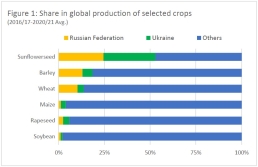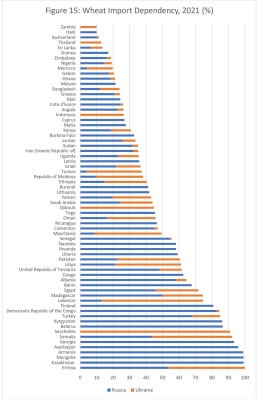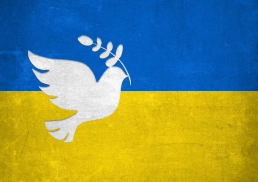UfU Information | Issue 5 – June 2022 | Department of Climate Protection & Transformative Education
Russian attack on Ukraine
How the Russian attack is jeopardizing the world’s food security
For years, experts have been warning of the effects of advancing climate change and the associated insecurity of food supplies worldwide. Heat, lack of rainfall and extreme weather events are leading to changes in agricultural cultivation conditions in many countries, and the global water shortage in particular is becoming increasingly acute. Adapting to these changed conditions is difficult and only possible slowly. This often results in lower crop yields and therefore higher food prices on the global food markets in the long term. Low-income countries suffer the most. This situation is now being exacerbated by the current war in Ukraine.
Wheat exports at great risk
Russia and Ukraine play a not inconsiderable role in the global food supply. Sunflower seeds, barley and wheat in particular are essential export products of these two countries. Russia is the world’s largest wheat exporter with more than 32.9 million tons, while Ukraine is in fifth place with more than 20 million tons.
Many agricultural products from Ukraine and Russia are mainly exported to so-called low-income food-deficit countries, i.e. countries with low incomes and large food deficits. Eritrea, Kazakhstan and Mongolia source almost all of their wheat requirements from Russia and Ukraine. But Tanzania, Namibia, Congo, Rwanda and Somalia also import more than 50 percent of their own wheat requirements from these two countries.
The resulting dependence of these countries on exports from Ukraine and Russia poses a serious threat to food supplies. This demand is no longer covered. Since Russia’s attacks on Ukraine, work in the ports in the Black Sea has practically come to a standstill. This leads to limited availability on the global food markets, unmet demand for imports and higher international food prices. Russia’s attack on Ukraine is therefore not only endangering the lives of Ukrainian citizens, it can also lead to severe malnutrition and famine worldwide.
Average share of production of various cereals for Russia, Ukraine and others

Sowing time In the Ukraine
Arif Husain, Chief Economist of the World Food Program, is now very concerned about the global food supply: “To be honest, I am very worried. The people in Ukraine are in a disastrous situation and are fighting for their lives. But this disaster will also harm people beyond the borders and thousands of kilometers away.” (https://www.capradio.org/news/npr/story?storyid=1083769798)
The timing for this war could not have been more unfavorable. At this time of year, the fields in Ukraine should be planted with corn, barley and sunflowers. At the same time, the next big wheat harvest is due in the summer. However, most people in Ukraine are either on the run or at war. The Food and Agriculture Organization of the United Nations estimates that 20 percent of the areas planted in winter cannot be harvested in summer due to direct destruction, limited access or a lack of economic resources. This could have fatal consequences, especially in the coming season.
Wheat prices could double
Currently, wheat prices are already reaching record highs due to the lack of exports and are even exceeding the price level recorded during the global food crisis of 2007-2008. At that time, wheat prices rose sharply due to the serious production declines in the leading producer countries Australia and Russia. This global food crisis gave rise to other crises. The rise in grain prices is considered to be one of the triggers of the “Arab Spring” uprisings in the Middle East in 2009-2010. The food prices at the time pushed many people in the Middle East to the brink of their own existence and led to mass protests and demands for reform.
Dependence of various countries on wheat exports from Russia and Ukraine

The longer the war in Ukraine lasts, the more serious the consequences could be, not only for Ukrainians themselves, but also for the global food supply. If farmers in Ukraine do not start sowing preparations soon, experts fear that this will lead to a food security crisis. Grain production in Ukraine could fall so sharply in the coming season that the price of wheat will double or triple accordingly.
Poorer countries hit hardest
The United Nations World Food Programme (UN WFP), which supplies grain and food for distribution to poor countries, bought around 1.4 million tons of wheat last year, 70 percent of which came from Ukraine and Russia. Before the Russian invasion of Ukraine, the world was already facing a 30 percent increase in wheat prices due to low yields in Canada, the USA and Argentina. This recent rise in grain prices is expected to further limit the ability of the United Nations World Food Program to provide aid. Meanwhile, some simulations by the Food and Agriculture Organization of the United Nations show that the global number of undernourished people could increase by 8 to 13 million in 2022/23. The largest increase is expected in the Asia-Pacific, Sub-Saharan Africa, Middle East and North Africa regions. Due to extreme heat or other severe climatic conditions, wheat and other cereals are difficult or impossible to grow in these regions. These countries therefore import wheat from Ukraine and Russia.
However, Arif Husain emphasizes that prices will rise due to the interconnectedness of global commodity markets, even in countries that do not currently source their wheat, corn or other commodities directly from Ukraine or Russia: “Any disruption that occurs anywhere in the food chain will definitely have an impact elsewhere,” says Husain.

The Ukrainian Red Cross is collecting donations at:
https://donate.redcrossredcrescent.org/ua/donate/~my-donation?_cv=1



